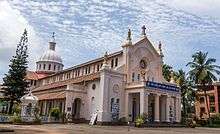Our Lady of Rosary Cathedral, Mangalore
| Our Lady of Rosary of Mangalore Mangalore Cathedral | |
|---|---|
 | |
| Basic information | |
| Location | Mangalore, Karnataka, India |
| Geographic coordinates | 12°51′22″N 74°50′12″E / 12.856113°N 74.836550°ECoordinates: 12°51′22″N 74°50′12″E / 12.856113°N 74.836550°E |
| Affiliation | Catholic |
| District | Dakshina Kannada |
| Country |
|
| Year consecrated | 1568 |
| Ecclesiastical or organizational status | Active |
| Website |
www |
Church of Our Lady of Rosary of Mangalore (Portuguese: Igreja Nossa Senhora do Rosário de Mangalore), or Rosario Cathedral is a Roman Catholic cathedral in the Roman Catholic Diocese of Mangalore, dedicated to Our Lady of the Rosary. It was the first Roman Catholic church in the Canara region.[1] Historically, this was the only parish church in Mangalore reserved for the high-caste Mangalorean Catholics.[2] It is the oldest church in Karnataka.
History
The church of Our Lady of Rosary of Mangalore was originally the church of the old Portuguese factory.[1] It was built by the Portuguese in 1568.[3] Oral tradition states that the image of the Virgin Mary at the high altar was found by the fishermen at sea; when it got caught in their net.[1] It was later brought to the church and installed there.[1] The church was the main centre of devotion for the Bamonn caste who revered the image of Our Lady of the Rosary on the high-altar.[1] It was mentioned by the Italian traveller Pietro Della Valle, when he visited Mangalore in 1623.[3]
The church was desecrated and destroyed by Mysorean ruler Tipu Sultan in 1784.[4] Reconstruction of the church later began in 1813.[3] In 1910, the structure of the old cathedral was demolished and the present cathedral erected in its place.[3] The church of Our Lady of Rosary is the only church in the Mangalore Diocese which has a dome crowning the spacious sanctuary.[3] The cross on the cathedral's dome was traditionally lit every night to serve as a beacon for seafarers.[3] The Royal stone emblem of the Portuguese King marking their landing at Mangalore lies at the entrance of the church.[3]
In 1851, the Church of Our Lady of Rosary, Mangalore, was declared a Cathedral. In 1910, Henry Buzzoni a Jesuit priest started further beautification of the Cathedral. The formal dedication was done in 1915 by Bishop Paul Perini of Mangalore (1910-28).[5]
Structure
The architect of the new cathedral was a Jesuit brother, Divo of Bombay. The structure consists of a series of matching arches, with 48 major arches, 12 central arches and 50 sub-arches. The peripheral verandah has around 45 small arches.
The dome is a replica of the St. Peter's Basilica, Vatican City, with heavy metal ribs, minor re-inforcements of metal, red brick & mortar water-proofed using indigenous techniques. In years gone by, the dome of the cathedral could be seen by ships approaching the Mangalore harbour, and was a beautiful sight.[5]
Citations
- 1 2 3 4 5 Silva & Fuchs 1965, p. 8
- ↑ Silva & Fuchs 1965, p. 7
- 1 2 3 4 5 6 7 Kamila 2004
- ↑ D'Souza 1983, N. 11, p. 40
- 1 2 Saldanha-Shet, I J (25 March 2014). "An exquisite edifice in Mangalore" (Bangalore). Deccan Herald. Retrieved 19 January 2015.
References
| Wikimedia Commons has media related to Our Lady of Rosary Cathedral, Mangalore. |
- D'Souza, A. L. P. (1983), History of the Catholic Community of South Kanara, Desco Publishers .
- Kamila, Raviprasad (27 November 2004), The holy heritage, The Hindu, retrieved 20 May 2011
- Silva, Severine; Fuchs, Stephan (1965). "The Marriage Customs of the Christians in South Canara, India" (PDF, 2.48 MB). Asian ethnology. 2. Nanzan Institute for Religion and Culture, Nanzan University (Japan). 24: 1–52. Retrieved 20 May 2011. External link in
|journal=(help)